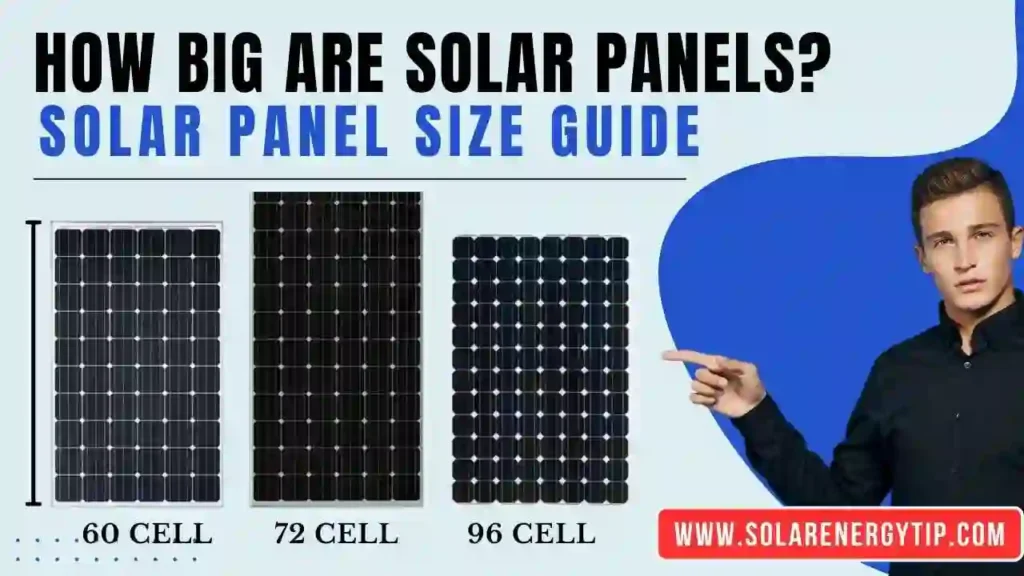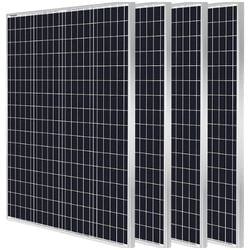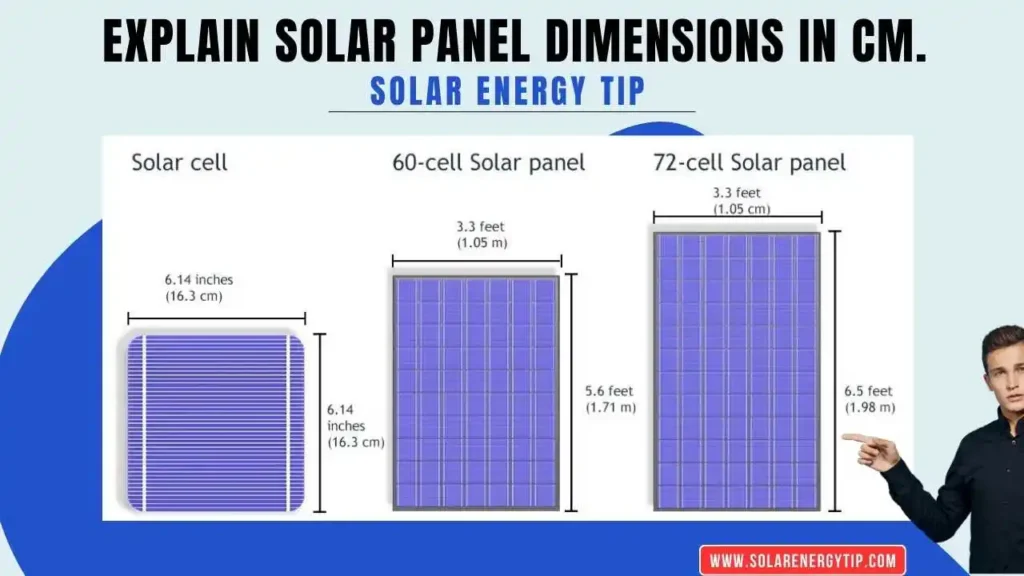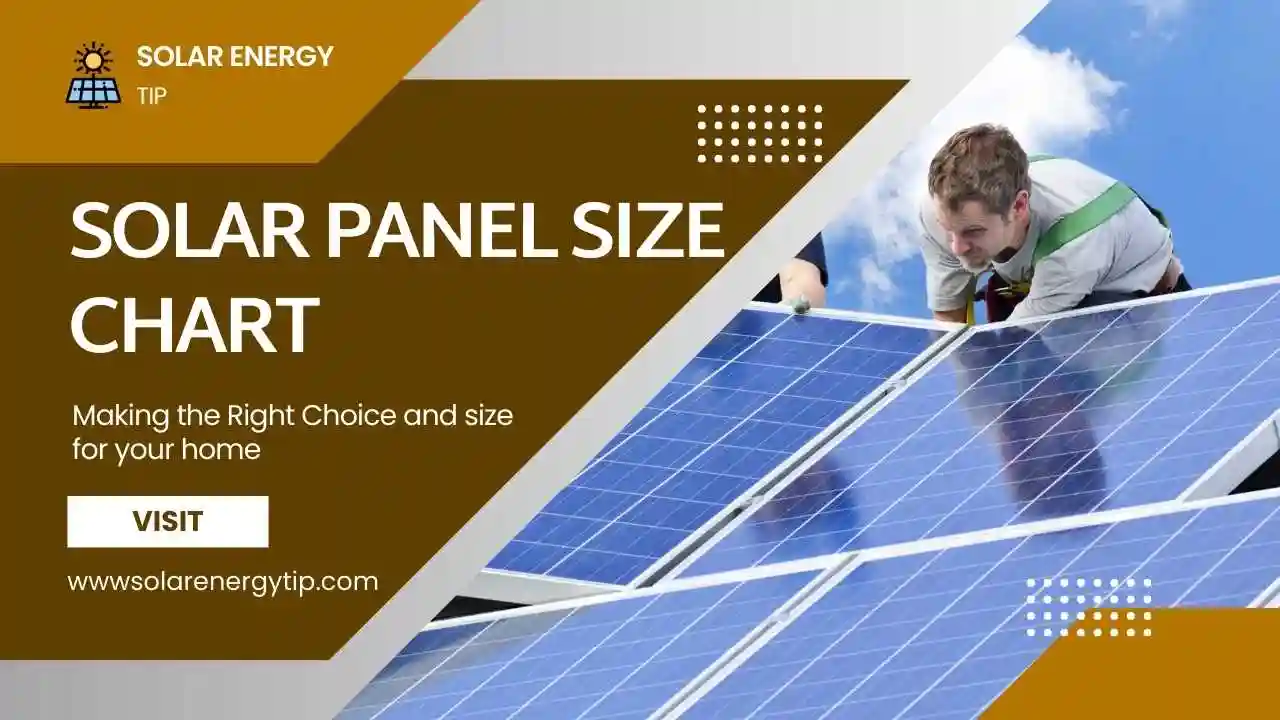Today, my dear solar energy friends, we will learn about solar panels’ size and design. Here, we discuss a solar panel size chart.
Friends, if you want to install a rooftop solar installation in your area, at your home, or in your place of business, and there are some space limitations for you, then you need to study the size of the solar panel design.
Today, more than 3% of U.S. electricity comes from solar energy through solar photovoltaics (PV) and centralized solar-thermal power (CSP), according to the U.S. Department of Energy.
At such a time, you need to get information about the size of the solar panel for your knowledge.
So, read my article to learn about solar panel size and design to fit your roof space.
Have you seen a rooftop solar system in your area? For that, we explain solar panel sizes, requirements, and weight.
In the end, if you have any questions about this topic, then please comment below.
- How Big are Solar Panels?: Solar Panel Size Guide
- How to Size a Solar System [Step-by-Step Guide]
- Solar Panel Size Chart and Wattage Calculator
- Find Solar Panel Size Chart For Your Use
- Top 10 Most Efficiency Solar Panels in 2024
- Solar Panel Dimensions mm
- Solar Panel Size Per kw
- Explain Solar Panel Dimensions In cm.
- FAQs
- Conclusion
How Big are Solar Panels?: Solar Panel Size Guide

Size matters when it comes to solar panels. Wattage indicates how much power a panel can produce per hour is the most critical measurement.
Solar Panels Size Chart By The Number Of Cells
There are three standard sizes of home solar panels on the market by the number of cells:
- 60-cell panels: These modest, cheap solutions suit tiny houses and low-energy use. Standard-sized 6×10 panels measure 3.25 x 5.5 feet and are placed in a grid.
- 72-cell panels: These more extensive and powerful models are ideal for medium-sized houses with modest electricity needs. In a 6×12 grid pattern, these panels measure 3.25 x 6.42 feet.
- 96-cell panels: Big lads, these vast, high-wattage panels are suitable for energy-intensive households and businesses. Panels are 41.5 x 62.6 inches and have an 8×12 grid arrangement.
Here, you are shown a solar panel size chart based on 60 vs 72 vs 92 cell solar panel dimensions and wattage.
| Solar Panel Size | Dimensions (W x H x D) | Wattage |
|---|---|---|
| 60-cell | 39″ x 66″ x 1.3″ – 1.6″ | 300-350W |
| 72-cell | 39″ x 77″ x 1.3″ – 1.6″ | 350-400W |
| 96-cell | 41.5″ x 62.6″ x 1.38″ | 400-450W |
Solar Panels Size Chart By The Type of Solar Panels
There are various types of solar panels in the market. Each form has distinct advantages and factors to consider when selecting the appropriate solar panel size.
- Monocrystalline Solar Panels
- Polycrystalline Solar Panels
- Thin-Film Solar Panels
- Bifacial Solar Panels
👉 The dimensions, system size, number of panels needed, and annual average production of the above types of solar panels are listed in the tables below.
| Type of Solar Panel | Width (inches) | Height (inches) | Depth (inches) | System Size | Panels Required | Average Annual Production |
|---|---|---|---|---|---|---|
| Monocrystalline | 65 | 39 | 1.4 | 5 kW | 13 | 6,000 kWh |
| Polycrystalline | 65 | 39 | 1.4 | 5.5 kW | 14 | 6,200 kWh |
| Thin-Film | 77 | 39 | 1.2 | 6 kW | 15 | 6,500 kWh |
| Bifacial | 78 | 41 | 1.6 | 7 kW | 17 | 7,200 kWh |
How to Size a Solar System [Step-by-Step Guide]
![How to Size a Solar System [Step-by-Step Guide]](http://solarenergytip.com/wp-content/uploads/2023/03/How-to-Size-a-Solar-System-Step-By-Step-Guide-1024x576.webp)
Hey, green team, Are you ready to go solar but unsure where to start sizing your system? Let me walk you through it in five easy steps:
- Step 1: Calculate your average daily kWh usage – Check your utility bills to estimate how much power your home uses daily.
- Step 2: Determine the correct solar panel wattage – Use an online calculator to find the optimal wattage based on location and usage.
- Step 3: Decide on a panel type – Choose 60-cell, 72-cell, or 96-cell panels based on your power needs and roof space.
- Step 4: Figure out the number of panels – Divide your ideal system wattage by the wattage of your chosen panel to get the quantity.
- Step 5: Verify it fits your roof – Measure your usable roof square footage and layout panels on a map to confirm sufficient space.
Follow this simple sizing approach to get a solar array that meets your household’s needs. A perfect system saves more and generates clean energy. Contact me for process assistance.
Solar Panel Size Chart and Wattage Calculator

Here’s an idea of how to use a solar panel for your home, a calculator, and how to calculate it. Solar Panel Size Chart Calculator.
Solar Panel Wattage Calculator
The calculator shows how much electricity you can generate per day based on the type of solar panel, how many solar panels you use, and the average daily sunlight.
Find Solar Panel Size Chart For Your Use
The solar panels used for all residential solar projects come in a standard size.
These are the kind that meet the needs of most homeowners, as they fit on most roofs and generate enough energy to reduce the monthly electric bill significantly.
Did you know?
Roofs often vary in size. Your solar contractor will assist you in finding alternative-sized solar panels or installing them on your land if you have this type of roof.
We have created different types of solar panel size charts according to their use, which will help you.
- Portable Solar Panel Size Chart for Popular Brands,
- Residential and Commercial Solar Panel Size Chart
- Comparison of Commercial and Residential Solar Panels.
Portable Solar Panel Chart for Popular Brands
Here are the names of some of the world’s most popular portable Solar Panel Size Charts.
Portable solar panels have undergone numerous changes and improvements in recent times.
| Brand | Folded Dimensions | Weight | Wattage | Recommendations |
|---|---|---|---|---|
| Renogy 100 Watt Foldable Portable Solar Panel | 19.9 x 27.2 x 2.8 inches | 26.6 lbs. | 100 | Check Here |
| OUTAD Portable Solar Panel Generator | 32.5 x 19.9 x 2.8 inches | 33 lbs. | 102 | Check Here |
| Jaackery SolarSage 100W Portable Solar Panel | 26 x 22.5 x 2.5 inches | 11.6 lbs. | 100 | Check Here |
| Goal Zero Nomad 20 | 8.5 x 13 x 1 inches | 2 lbs. | 20 | Check Here |
| HQST Off-Grid 100W Solar Panel | 20 x 27.3 x 3.1 inches | 21.7 lbs. | 100 | Check Here |
The above solar panels are only for these unique products. Those solar brands offer other solar panels in different sizes.
Residential and Commercial Panel Size Chart
The sizes of the most popular Solar Panel Size Charts for residential and commercial use are listed below.
These are for specific products only. It may be available in other positions of the following brands.
| Brand | Dimensions | Weight | Recommendations |
|---|---|---|---|
| SunPower X-Series 72-Cell Solar Panels | 61.3 x 31.4 inches | 41 lbs | Check Here |
| Q CELLS 60-Cell Solar Panel | 65.8 x 39.4 inches | 41 lbs | Check Here |
| Hyundai PERL Monocrystalline Solar Panel 60 Cells 60 cells | 64.5 x 39.29 inches | 42 lbs | Check Here |
| Q CELLS 72-Cell Solar Panel | 78.5 x 39.4 inches | 52.9 lbs | Check Here |
| TrinaSolar TSM 260 PD05 | 65 x 39 | 40 lbs | Check Here |
| Hyundai PERL Monocrystalline Solar Panel 72 Cells 72 cells | 77.17 x 39.29 inches | 52 lbs | Check Here |
| Jinko Solar JKM250P-60 | 65 x 39 | 38 lbs | Check Here |
| LG 60-Cell Solar Panels | 65 x 40 inches | 37.5 lbs | Check Here |
| LG 72-Cell Solar Panels | 80 x 40 inches | 46 lbs | Check Here |
Comparison of Commercial and Residential Solar Panels.

HQST Monocrystalline Solar Panel-
400w
- 400W monocrystalline solar panel with 21% conversion efficiency.
- Resistant aluminium frame
- Easy installation with junction box and MC4 connectors.
The solar panel size charts for residential and commercial properties are similar in the US; Solar is a standard application for residential use today that also applies to commercial purposes.
Most homes in the US and elsewhere are commercial entities using a similar solar power system.
| Type | Typical Number of Solar Cells | Length | Depth | Width |
|---|---|---|---|---|
| Residential | 60 | 65 inches | 1.5 to 2 inches | 39 niches |
| Commercial | 72 | 78 inches | 1.5 to 2 inches | 39 inches |
How to Size a Solar Power System For Residential tutorial below: watch it now.
Top 10 Most Efficiency Solar Panels in 2024
Solar panels have their efficiency measured in laboratory conditions.
It is unlikely that your home will receive the statistics of the solar system.
However, there is an excellent way to compare different solar panels based on the efficiency rating
| Manufacturer | Maximum Efficiency |
| Solaria | 20.50% |
| SunPower | 22.80% |
| LG | 22.00% |
| REC Solar | 21.70% |
| Hanwha | 20.30% |
| Panasonic | 21.20% |
| LONGi | 20.90% |
| Q-CELLS | 20.60% |
| JinkoSolar | 20.38% |
| JA Solar | 20.40% |
Solar Panel Weight by Some Manufacturers
To install a rooftop solar system, you must know the solar panel’s weight.
One of the best ways to ensure that your roof can support a complete solar installation is to maintain the weight of the solar panel.
Below are the 10 most common brands of solar panels and some of their results, as well as what your solar contractor can tell you about which solar panel model is best for you.
| Solar Panel Manufacturer | Solar Panel weight (60-cell Residential Panels) |
|---|---|
| LG | 38 lbs |
| Canadian Solar | 40 – 51 lbs |
| Hyundai | 38 – 41 lbs |
| Kyocera | 42 – 44 lbs |
| Hanwha SolarOne | 40 – 42 lbs |
| Hanwha Q CELLS | 41 lbs |
| Trina | 41 – 50 lbs |
| SunPower | 33 – 41 lbs |
| SolarWorld | 40 – 47 lbs |
| Axitec | 39 – 41 lbs |
The top branch you compared here had the lightest power, with some panels weighing 33 pounds, and the heaviest Canadian Solar had a panel weighing 80 pounds.
Solar Panel Dimensions mm
If we study the dimensions of solar panels, the dimensions of residential solar panels are usually 65 inches in length and 39 inches in width, with depths ranging from 1.5 to 2 inches.
In addition, for solar panels for commercial use, you have to expect a length of about 78 inches and a width of around 39 inches. For solar panels for commercial use, the depth is about two inches.
👉 For example, a SunPower panel is 61.3 by 41.2.
How big is a 300w polycrystalline silicon solar panel?
The 300-watt solar panel of polycrystalline silicon in the US has a length of 195.6 cm, a width of 99.2 cm, and a depth of 5 cm, and its average weight is about 23 kg.
Solar Panel Size Per kw
A solar panel’s average size for installing a rooftop solar system is approximately 65 inches by 39 inches or 5.4 feet by 3.25 feet.
And if you want to install a solar system on a large scale like your warehouse or an institutional building, your panel will be as long as 6 feet. This type of solar panel is known as commercial.
Each solar panel is made up of individual photovoltaic cells. Photovoltaic cells come in standard sizes of 156mm by 156mm, about 6 inches long and 6 inches wide.
Explain Solar Panel Dimensions In cm.
Most solar panels for your rooftop solar installation are made up of 60 solar cells. While the standard for commercial installation is made up of 72 solar cells.

There is nothing too much for you to choose between the two standard sizes of solar panels.
The main thing influencing your decision to go for 60-inch or 72-inch solar panels is how much space is available for your solar system and how it will fit into it.
| Type | Average Dimensions of panels | In CM | Square Measure |
| 60 cell panel | 39 x 65 inch | 105 x 171 cm | 17.6 square feet |
| 72 cell panel | 39 x 77 inch | 105 x 198 cm | 20.9 square feet |
Given the length and width of solar panels, the length and width of traditional rigid panels vary slightly from one manufacturer to another.
Most manufacturers stick to the size of standard panels, while others come with their own unique sizes.
Following are some common prevailing size results
- 60-cell panels: 39 ”W x 66” L
- 72-Cell Panels: 39 ”W x 77” L
- 96-cell panels: 41.5 ”W x 62.6” L.
Depending on the solar panel manufacturer, these panels can be as large as one or two inches on each side.
However, conventional solar systems use only 60 or 72 cells; such solar panels are the standard for residential and commercial installations.
FAQs
Q1. What is the standard size of a solar panel?
The dimensions of solar panels installed in a typical residential area today are approximately 65 inches by 39 inches or 5.4 feet by 3.25 feet, with some slight differences in manufacturers.
This is one of the standard global solar panel size charts discussed in detail in the above article.
If you have any left to read, read on.
Q2. How do you calculate the size of a solar panel?
You cannot correctly measure your solar photovoltaic system unless you know exactly how much electricity your home needs, how much electricity your home uses, and how much electricity you will use in the future.
The easiest way to determine how much electricity your home uses is to look at your previous electricity utility company’s bills. You will see how much electricity you have used in the last month or the last quarter.
Q3. How many kWh will a 300-watt solar panel produce?
A 300-watt solar panel with an average radiation value of 4 peak sun hours per day produces 1.2 kWh of electrical energy daily.
Conclusion
If we look at the time solar panel size chart in this article, there is not much change in their size, and it is not a cause for concern.
As you can see, solar panels for the home are more or less the standard size, depending on the placement.
Additionally, physical dimensions are less of a problem with portable panels as they are designed to be easy to use anywhere.
Once you have figured out how much power you need, based on the correct parameters, you will need to support your solar system installation.
Here, you will find information on managing a solar panel using a size chart in your home.

